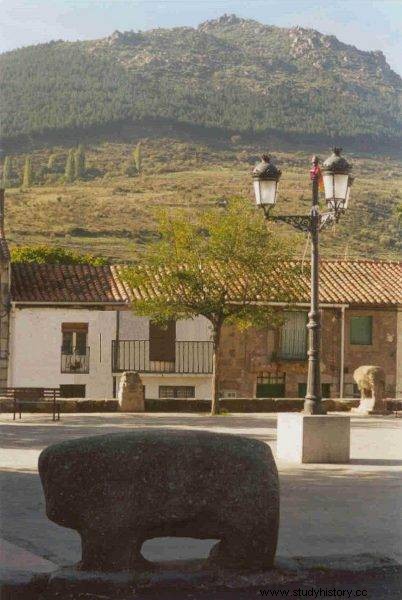In the area of pre-Roman Iberia, over 400 of them have already been found. Stone statues, sometimes reaching 2.75 meters in length, depicting animals including bulls, pigs. Characteristic of the Celtic societies of the Iberian Peninsula. How is it possible that two of them went as far as the Ślęża mountain?
Referred to as verracos in the professional literature - stone statues of bulls, boars and pigs - this is one of the most characteristic elements of the Wettonian culture. The Wettons were the pre-Roman people of central Iberia and are associated with the Celts. It was mainly in the area where they inhabited that huge statues of animals were found.
More than 400 verracos pieces have been discovered so far . They were of extraordinary size, from 1 to as much as 2.75 meters in length. A single statue usually weighed between 3 and 8 tons. Monumental animals made of granite are still a mystery to researchers today, because they are usually found in an archaeological context, which does not allow to define their functions with certainty. However, this does not stop scientists from trying to interpret these unusual figures.
Mysterious animals
So what could they be? Most stone animals have been found in open spaces. Situated in fields, near watercourses and far away from human settlements. This location prompts researchers to draw two conclusions. First, the statues of animals could have a magical function . Perhaps they were meant to protect the flock, which in Celtic times was of great value to the community.

Most stone animals have been found in open spaces. Situated in fields, near watercourses and far away from human settlements.
Another, more down-to-earth interpretation suggests that monumental bears, boars, and pigs were a kind of marker. Their task was to fence off pastures and to establish control over access to natural resources . Such a role is also compatible with the structure of a hierarchical society.
The verracos part found in the immediate vicinity of fortified settlements, which were abandoned after the conquest by Rome. Their location in places with excellent visibility may confirm both of the previously cited theories. Therefore, they could have a protective function of the places where they were placed, as well as an organizational one, thus dividing the areas into smaller areas belonging to a specific population.
Great tombstones
But the "bear cubs" were also found in a completely different context. In cemeteries, they could be used as tombstones. However, most of them are examples of the re-use of these monumental statues.
Due to the nature of the places where verracos we find, it is extremely difficult to determine their exact chronology. However, we can approximately say that they were created between the 4th and 1st century BC. They certainly were of great importance to pre-Roman society. This is indicated by the fact that they were still in operation in Roman times. Even Latin inscriptions have been found on some of them.
Celts in Poland
How is it then possible that such unique and huge monuments have found their counterpart on the other side of Europe? Where did a couple of such "bears" come from on our Polish Ślęża?
The Ślęża Massif is an unusual sight in the Polish landscape. The hill reaches a height of 717.5 m above sea level. and has long aroused unusual feelings in people. Ślęża very often hides behind clouds, here also "storms are born" - this area is very often subject to electric discharges. Such amazing phenomena have always attracted human attention. It was no different in this case.

Ślęża was a place where many pre-Christian cult rituals were held.
Thanks to archaeological materials and written sources, we can conclude that Ślęża was a place where many pre-Christian cult rituals were held . Moreover, this mountain hosted representatives of not only one culture!
During the research on the Ślęża Massif, two statues similar to those described earlier were found. Researchers called them "boar" and "bear" for the sake of distinction. Both are now associated with the La Tene culture, which is associated with Celtic communities.
The remains of the La Tene culture in Poland are concentrated in the enclaves of the southern part of the country. Both remains of Celtic settlements and graves have been found in the vicinity of the Ślęża massif. It should therefore not be surprising that monuments related to the cult activities taking place here were also discovered at the top of the mountain.
Silesian "bears"
The sculptures, although found at a distance from each other, are considered to be a pair. Their dimensions are approximately 1 meter in height and 1.47 and 1.7 meters in length. The "bear" currently located at the top of the massif was transported to its present location in 1903. The second statue can be admired on the way to the top next to another, known as the "Maid with a Fish".
Of course, we cannot directly connect the stone statues of central Iberia with the pair found in Ślęża. However, our Silesian monuments certainly give food for thought.
It is also not without significance that in the times of the La Tene culture, the Iberian Peninsula had mutual contacts with the Rhineland. It happens that similar ideas emerge at the two extreme periphery of one cultural area. However, we cannot categorically state whether our Polish "bear cubs" come from the same cultural source as Iberian sculptures.
Literature:
- E. Àlvarez-Sanchiz, Oppina and Celtic society in western Spain , e-Keltoi, vol. 6, pp. 255–285.
- J. Lorrio, G. R. Zapatero, The Celts in the Iberian Peninsula , e-Keltoi, vol. 6, pp. 167-254.
- Woźniak, The problem of the existence of the Celtic "nemeton" in Ślęża , Przegląd Archeologiczny, vol. 52, 2004, pp. 131–183.
